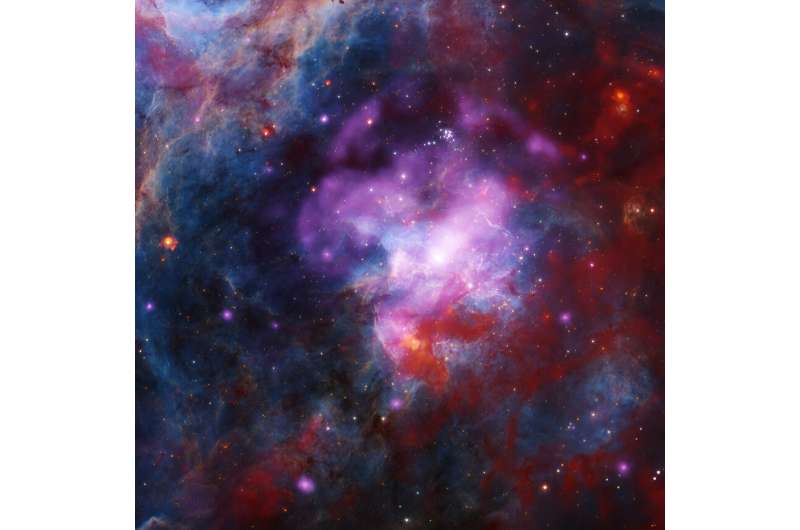
A colorful, festive image shows different types of light containing the remains of not one, but at least two exploded stars. This supernova remnant is known as 30 Doradus B (30 Dor B for short) and is part of a larger region of space where stars have been continuously forming for the past 8 to 10 million years. It is a complex landscape of dark clouds of gas, young stars, high-energy shocks, and superheated gas, located 160,000 light-years away from Earth in the Large Magellanic Cloud, a small satellite galaxy of the Milky Way.
The new image of 30 Dor B was made by combining X-ray data from NASA’s Chandra X-ray Observatory (purple), optical data from the Blanco 4-meter telescope in Chile (orange and cyan), and infrared data from NASA’s Spitzer Space Telescope (red). Optical data from NASA’s Hubble Space Telescope was also added in black and white to highlight sharp features in the image.
A team of astronomers led by Wei-An Chen from the National Taiwan University in Taipei, Taiwan, have used over two million seconds of Chandra observing time of 30 Dor B and its surroundings to analyze the region. They found a faint shell of X-rays that extends about 130 light-years across. (For context, the nearest star to the sun is about four light-years away). The Chandra data also reveals that 30 Dor B contains winds of particles blowing away from a pulsar, creating what is known as a pulsar wind nebula.
The paper led by Wei-An Chen describing these results was recently published in the Astronomical Journal. The co-authors of the paper are Chuan-Jui Li, You-Hua Chu, Shutaro Ueda, Kuo-Song Wang, Sheng-Yuan Liu, all from the Institute of Astronomy and Astrophysics; Academia Sinica, in Taipei, Taiwan, and Bo-An Chen from National Taiwan University.
Taking the Chandra data together with data from Hubble and other telescopes, the researchers determined that no single supernova explosion could explain what is being seen. Both the pulsar and the bright X-rays seen in the center of 30 Dor B likely resulted from a supernova explosion after the collapse of a massive star about 5,000 years ago. The larger, faint shell of X-rays, however, is too big to have resulted from the same supernova.
Instead, the team thinks that at least two supernova explosions took place in 30 Dor B, with the X-ray shell produced by another supernova more than 5,000 years ago. It is also quite possible that even more happened in the past.
This result can help astronomers learn more about the lives of massive stars, and the effects of their supernova explosions.
More information:
Wei-An 韋安 Chen 陳 et al, New Insights on 30 Dor B Revealed by High-quality Multiwavelength Observations, The Astronomical Journal (2023). DOI: 10.3847/1538-3881/acff72
Citation:
NASA telescopes start the year with a double bang (2024, January 3)
retrieved 4 January 2024
from https://phys.org/news/2024-01-nasa-telescopes-year.html
This document is subject to copyright. Apart from any fair dealing for the purpose of private study or research, no
part may be reproduced without the written permission. The content is provided for information purposes only.

